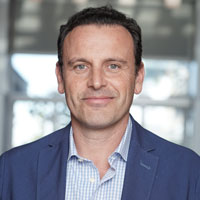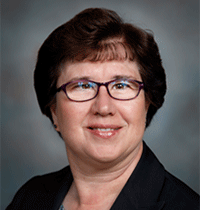Monday, September 9
Materials and Structural Testing Using Elastic Waves
8:00AM – 9:20AM
Olmstead 1-2, Level 3

Francesco Lanza di Scalea
Director, Experimental Mechanics and NDE Laboratory
University of California San Diego
Title: Materials and Structural Testing Using Elastic Waves
Abstract: The detection and quantification of internal defects as well as the measurement of in-situ stresses in materials and structures can be well accomplished by using elastic waves propagating in the ultrasonic regime (> 20 kHz). The talk will present four research topics related to this theme. The first topic is the passive-only extraction of the Green’s function (or transfer function) of the test piece subjected to an unknown, and generally nonstationary excitation. This concept is being successfully utilized to defect internal defects in rail tracks using solely (non-contact) ultrasonic receivers and exploiting the natural train wheels as the acoustic excitation. Several other opportunities exist to passively monitor structures subjected to natural operational loads. The second topic deals with the nonlinear wave propagation regime and the increased sensitivity that this brings to nondestructive material state awareness compared to the conventional linear wave regime. Nonlinear wave propagation will be presented for the case of waveguides, affected by multimode and dispersive behavior, and for the case of constrained solids subjected to thermal excursions. One application of the latter case is the nondestructive assessment of in-situ thermal stresses for the prevention of thermal buckling failures. The third topic consists of improvements to the application of ultrasonic Synthetic Aperture Focus (SAF) that utilizes multi-element ultrasonic arrays to image defects in engineering solids and biological materials. Applications will be shown to image internal defects in aluminum and steel bulk parts. The fourth topic is the identification of the elastic constants of multilayered composite materials based on guided wave propagation and optimization algorithms.
Biography: Francesco Lanza di Scalea (Ph.D. 97 Univ. of Palermo-Italy, Post-doc 98-99 Johns Hopkins Univ.) is currently a Professor of Structural Engineering and the Director of the Experimental Mechanics & NDE Laboratory at the University of California San Diego. His research and teaching interests are in the fields of experimental mechanics, non-destructive evaluation and structural health monitoring. Lanza di Scalea was awarded the UCSD Structural Engineering Teacher of the Year Award twice (2011 and 2018), the Structural Health Monitoring Person of the Year Award (2007), the American Society for Nondestructive Testing Research Fellowship Award (2002, 2006 and 2010), the American Society for Nondestructive Testing Faculty Grant Award (2003), the UCSD Hellman Faculty Fellowship (2000 and 2002), and the Fulbright Scholarship (1995). He currently serves on the Editorial Board of the following journals: Journal of Intelligent Materials Systems and Structures, Structural Health Monitoring: An International Journal, Research in Nondestructive Evaluation, ASME Journal of Nondestructive Evaluation, Diagnostics and Prognostics of Engineering Systems, and SEM’s Experimental Mechanics. He is a Fellow of the following societies: American Society for Nondestructive Testing (ASNT), Acoustical Society of America (ASA), and Society for Experimental Mechanics (SEM). He is a Senior Member of IEEE.
Tuesday, September 10
Presentation: Engineering Research Centers – Past, Current and Future
8:00AM - 9:20AM
Olmstead 1-2, Level 3

K.W. Wang, Ph. D.
Division Director
Division of Engineering Education and Centers
Directorate for Engineering
National Science Foundation
Alexandria, VA 22314, USA
Title: Engineering Research Centers – Past, Current and Future
Abstract: During the recent decades, the scientific and engineering community and the federal agencies have explored the potential of large-scale center-type research programs. It has been recognized that many of the most challenging and complex technical problems can only be addressed if researchers with diverse expertise combine their efforts and work across the boundaries between disciplines. The National Science Foundation (NSF) Engineering Research Center (ERC) program is a flagship program in this regard.
The ERCs are interdisciplinary, multi-institutional centers that join academia, industry, and government in partnership to produce transformational engineered systems and educate individuals that are adept at innovation and primed for leadership in the global economy. They operate at the interface between the discovery-driven culture of science and the innovation-driven culture of engineering. Since the ERC program’s inception in 1984, NSF has funded over 70 ERCs across the United States. The NSF funding level has been at about $4 million per year for each ERC for up to 10 years, during which time the centers would develop partnerships with industry, universities, and other government entities to sustain them upon graduation from NSF support. Throughout the years, the ERCs have contributed significantly to the technical community and the nation; educated more than 12,000 engineering graduates with interdisciplinary training, produced a tremendous amount of high impact publications, patents and licenses, and spin-off companies. Studies have estimated that the total downstream market value of ERC innovations to the U.S. economy is well over tens of billions of dollars. Recently, NSF funded the National Academies of Sciences, Engineering, and Medicine (NASEM) to conduct a study to create a vision for future research centers in engineering (A New Vision for Center-Based Engineering Research, 2017, The National Academies Press). Building upon the NASEM’s recommendations, NSF developed a roadmap for the next generation of ERCs (Gen-4), which emphasizes cutting-edge research efforts that are convergent and will lead to strong societal impact. A Gen-4 ERC will have interacting foundational components that cover convergent research, workforce development, culture of diversity and inclusion, and innovation ecosystem. In this presentation, we will provide an overview of the NSF ERC program to date, as well as new opportunities for the Gen-4 ERCs.
Biography: Dr. Kon-Well Wang is the Stephen P. Timoshenko Professor of Mechanical Engineering (ME) at the University of Michigan (U-M) in Ann Arbor, MI. He is also on an Executive IPA (Intergovernmental Personnel Act) appointment as Division Director of the Division of Engineering Education and Centers (EEC), Directorate of Engineering, at the National Science Foundation (NSF) in Alexandria, VA, since January 2019. The NSF EEC invests in the creation of 21st century engineers and the discovery of technologies through transformational center-based research including the Engineering Research Centers (ERCs), research in education and inclusion, and research opportunities for students and teachers.
Dr. Wang received his Ph.D. degree in Mechanical Engineering from the University of California at Berkeley in 1985, worked at the General Motors Research Labs as a Senior Research Engineer, and started his academic career as a faculty at the Pennsylvania State University in 1988. During his Penn State years, Dr. Wang has served as the William E. Diefenderfer Chaired Professor in Mechanical Engineering, Director of the Structural Dynamics and Controls Lab, Associate Director of the Vertical Lift Research Center of Excellence, and Group Leader for the Center for Acoustics and Vibration. Dr. Wang joined the U-M ME in 2008 and has been the Stephen P. Timoshenko Professor since then. For ten years, he served as the Department Chair of Mechanical Engineering at U-M (2008-18), and assumed the title of the Tim Manganello/BorgWarner Department Chair from 2013 to 2018.
Dr. Wang’s main technical interests are in the emerging fields of structural dynamics & controls, including adaptive structures & materials systems, tunable metamaterials & metastructures, and origami mechanics, dynamics & controls, with applications in shape, vibration & wave controls, vibration energy harvesting, structural health monitoring, and vehicle & robotics system dynamics & controls. He has received various recognitions for his accomplishments, such as the Pi Tau Sigma-ASME Charles Russ Richards Memorial Award, the ASME J.P. Den Hartog Award, the SPIE Smart Structures and Materials Lifetime Achievement Award, the ASME Adaptive Structures and Materials Systems Prize, the ASME N.O. Myklestad Award, the ASME Rudolf Kalman Award, the ASME Adaptive Structures and Material Systems Best Paper Awards, the NASA Tech Brief Award, and the SAE Ralph Teetor Award. His major leadership activities in the professional community include being Chair of the ASME Technical Committee on Vibration and Sound, Chair of the ASME Mechanical Engineering Department Heads Executive Committee, member of the ASME Design Engineering Division Executive Committee, General Chair of the SPIE Damping and Isolation Conference and of the ARO Workshop on Smart Structures, Chief Editor for the ASME Journal of Vibration & Acoustics, Associate Editor of the Journal of Intelligent Material Systems & Structures, and Editorial Advisory Board Member for the Journal of Sound and Vibration. Dr. Wang is a Fellow of the ASME, AAAS, and IOP.
Wednesday, September 11, 2019
Presentation: SMASIS: Past, Present & Future
8:00AM – 9:20AM
Olmstead 1 – 2, Level 3

Nancy Johnson
Lab Group Manager and Technical Fellow
General Motors Research and Development
Title: SMASIS: Past, Present & Future
Abstract: When the SMASIS conference began, many of the technologies we are focused on today were in their infancy or not even started. The use of smart materials has gradually evolved from high-end, one of kind products for medical, military and aerospace applications to the point of viability for mainstream, high yield/low cost products for automotive applications. Many industries can benefit from the technology areas being addressed by the adaptive structures community. For the automotive industry, there are significant potential benefits to be realized including reduction in vehicle mass, added design flexibility and reduction in component size and cost.
This presentation will provide a history of SMASIS over the past 10 years. A review of the conference with anecdotes of experiences during the conference will be covered along with a review of the changes in technical focus. Key technology areas and symposium topics will be covered, and an outlook of future trends will be provided, especially as it relates to the automotive industry and our customers. Research in multifunctional systems and inflatable structures will be discussed.
Biography: Nancy Johnson is currently a Lab Group Manager and Technical Fellow at General Motors Research and Development in Warren, Michigan. When she joined the GM Research her research focus was on composite material structures and energy management. She established design and analysis methods for an all carbon composite body structure and led projects of the Automotive Composites Consortium. She is a founding member and Fellow of the American Society for Composites and was invited to give keynote addresses on the use of composites in the automotive industry.
In the late 1990s, she became interested in how smart materials and adaptive structures could be utilized in the automotive industry. She recognized their potential and formed a new team at GM by hiring additional researchers in India and Michigan to bring smart materials into product and manufacturing processes. She established GM’s strategy for smart materials and led the research necessary to enable the transition into real products while working to develop the necessary supply base. She conducted fundamental research necessary to advance smart materials in the automotive industry with a focus on shape memory alloys and shape memory polymers. Nancy has over 275 patents, many of which are in the area of smart materials and adaptive structures with many more in progress. Many of her patents are enablers for or specific applications utilizing smart materials in the automotive industry. Example applications are in the areas of vehicle aerodynamics, vehicle crashworthiness, occupant safety, and interiors. Her team developed design tools and established test procedures for smart materials-based devices and was responsible for getting shape memory based applications into production including the active hatch vent in Corvette. Nancy has over 80 publications on smart materials and their uses and applications.
Nancy continues to lead multifunctional systems research work spanning multiple groups at General Motors and at HRL Laboratories, suppliers, and universities including the University of Michigan. She is co-director of the General Motors/University of Michigan Collaborative Research Laboratory, which has broadened its focus from smart materials and design tool development to multifunctional active systems. For over 20 years, Nancy has actively participated in ASME’s Adaptive Structures and Materials Systems community. She is a Fellow of ASME and has served as chair of the Aerospace Division, was General Chair of the 2013 SMASIS conference, and currently serves on the conference executive committee.